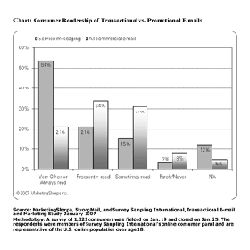I’m dancing around with a crazy grin on my face because this week is the first burst of decent sunny weather we’ve had in New England all year. It’s finally warming up for spring, and the relief is profound.
Which, as it turns out, is a very good thing because, otherwise, I would be horribly depressed. You see, I went up an entire dress size while coping with six months of gray unrelenting winter. So now I’m having to replace nearly every painfully tight item in my spring and summer wardrobe. Which is why my personal e-mail inbox is overflowing with online receipts and shipping notices.
One thing is missing from most of them. No promotions.
Very few e-commerce merchants, aside from travel marketers, bother to put house ads on shipping and sales receipts. Instead there seems to be a church-and-state divide between transactional and promotional e-mails. In fact, looking at most, you would never even guess that the transactional and the marketing e-mails came from the same company.
Most transactional messages are text only and sound like they were written by a robotic computer. They read like banking statements. Meanwhile, most promotions are HTML with big pictures and exclamation-ridden copy!
Why should you care? Check out this chart from MarketingSherpa’s new Ecommerce Marketing Study (plus, see below for a free chapter download hotlink):
As dry as transactional e-mails are, consumers are far, far more likely to open and review them than they are to look at your promotions. I can’t explain this. But I can recommend that you react to it.
For those of you who might be scared about adding house ads to transactional e-mails, MarketingSherpa’s research team has good news. We have been surveying consumers for four years now about how they feel about promos included in transactionals. At first, opinions were sharply divided. Some consumers loved the idea — why not get a special offer from a trusted merchant you just bought from? Some consumers hated the idea: Just say no to more commercials!
Our latest surveys, however, show that the strong emotions of past surveys have subsided. Consumers have received enough promotions that they don’t really seem to care one way or another whether their e-mail purchase confirmation or receipt includes a house ad. As long as their transactional message contains the facts they expect it to, it’s no skin off their noses if you toss in a promo offer too.
Some retailers have reacted to this news in a pussy-footing manner, adding house ads but putting them at the very bottom of the page. So ads are there, but no one will ever see or object to them. I think given today’s climate you can test moving your ads a bit higher up.
How? Why not copy Sprint Nextel’s transactional messaging tests? Sprint redesigned its transactionals into a two-column format. The wider, left column had the basic transactional facts. The thinner promotional column had special offers for additional items related to whatever the customer had just bought.
Results? Sales from these offers embedded into transactional messages did better than many of the company’s 100%-promotional broadcasts to the same list. Which, given the chart above, along with the rest of our Ecommerce 2007 data, is to be expected.
Anne Holland is president of MarketingSherpa, a research firm publishing buyer’s guides and benchmark data for its 237,000 marketing executive subscribers. For a free sample chapter PDF of MarketingSherpa’s new Ecommerce Study, go to:
www.marketingsherpa.com/exs/Ecom07Summ.pdf.
© MarketingSherpa, Inc. 2007
Other articles by Anne Holland:
The Thank-You Page Should Say More Than Thank You
How to Grow Your Opt-In List More Quickly and Easily
New Eye-Tracking Test Results: E-mail Campaign Click Patterns Surprise
New Data on Search Marketing Click Fraud: Three Action Items
Newest Eye-Tracking Study Results for Google
Absolutely Pitiful E-Commerce Shopping Cart Abandonment Stats…and Four Ways to Improve Yours
Study Data: Reasons to Get Evangelical About Evangelism Marketing
The Year’s Best and Worst Lead-Generation Offers
The Two Easiest (and Most Overlooked) Ways to Improve E-mail Response




